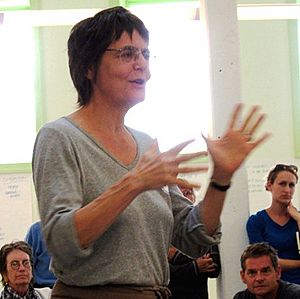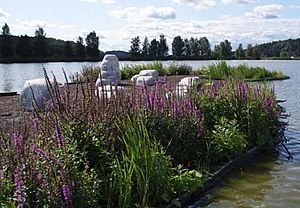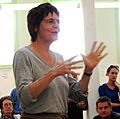Jackie Brookner facts for kids
Quick facts for kids
Jackie Brookner
|
|
|---|---|
 |
|
| Born | 1945 Providence, Rhode Island, U.S.
|
| Died | May 15, 2015 (aged 69) New York City, New York, U.S.
|
| Nationality | American |
Jackie Brookner (1945 – May 15, 2015) was an amazing artist, writer, and teacher. She created art that helped the environment, especially with water. Jackie worked with scientists, engineers, and local communities. Together, they made art projects that cleaned up water in parks, wetlands, and rivers. Her projects showed how local resources could bring people together to create something special.
Jackie lived in New York City and shared her ideas all over the world.
Contents
Education and Early Art
Jackie Brookner was born in Providence, Rhode Island. She went to Wellesley College and later studied art history at Harvard University. However, she decided to focus on making sculptures instead of finishing her Ph.D. In the 1970s, she moved to New York City to study drawing.
In the 1980s, Jackie started making sculptures inspired by water and plants. Later, she began to mix different materials like soil, velvet, and old car parts. She used these materials to explore feelings and ideas about them.
Soil Artworks
In the early 1990s, Jackie started thinking about how people treated the Earth. She used soil in her art to represent the raw material of our planet. She explored what "dirt" and "death" meant in different cultures.
Of Earth and Cotton (1994–98)
This project traveled to many places in the southern U.S. from 1994 to 1998. It followed the path of the Cotton Belt, where a lot of cotton was grown. In each city, Jackie talked to older farmers who had picked cotton by hand in the 1930s and 1940s.
She sculpted portraits of their feet using local soil. These foot sculptures were placed in art shows, sometimes on 60 tons of soil or 2,500 pounds of cotton! The exhibits also included videos of her talks with the farmers. There were also old photos from the 1930s showing what life was like for cotton farmers during the Great Depression.
Native Tongues, Barcelona, Spain (1997)
In Spain, Jackie listened to people speaking Castilian (Spanish) and Catalan languages. She imagined the shapes their tongues made when speaking. She then sculpted these "tongues" using soil from central Spain and Catalonia.
She also made a 50-foot wall drawing based on how sounds are made with the tongue. This art show explored how speech connects to a place and its history. This was especially important in Catalonia, where the local language was once banned.
Biosculptures: Living Art
Jackie became very interested in how art could help the environment. This led her to create her "Biosculptures." These are living water filtration systems that combine art with ecological function.
Biosculptures are like sculpted wetland ecosystems. They are made of mosses and plants growing on stone. The water they filter is home to fish, snails, and other organisms. The plants and tiny bacteria in their roots clean the water. They turn waste and pollution into food for themselves. This shows that in healthy natural systems, nothing is truly wasted.
The first Biosculpture was called Prima Lingua (First Tongue) in 1995. It looked like a large tongue that "licked" and cleaned polluted water. Another one, I’m You, made in 2000, looked like human hands but was based on tiny moss structures.
In many of her Biosculptures, Jackie used images of body parts, like hands or tongues. This showed how humans are part of a bigger, connected world, even though we often think of ourselves as separate.
Big Water Projects and Community Work
Since 2002, Jackie worked with many different people, including scientists, engineers, and local residents. Together, they created large-scale public art projects that cleaned water. These projects showed how dirty stormwater and other polluted waters could be cleaned. This helped bring back natural habitats in parks, wetlands, and rivers.
The Fargo Project, North Dakota (2010-ongoing)
Before she passed away, Jackie was working on an exciting project in Fargo, North Dakota. She worked with the city and local people to turn a large 18-acre stormwater basin into a useful neighborhood park. This park would have restored prairie and wetland areas. It would also include an orchard, natural play areas, an amphitheater, and community gardens to help feed families. This project was planned to be a model for 19 other similar areas in Fargo.
Veden Taika (The Magic of Water), Finland (2007–09)
Veden Taika means "The Magic of Water." This project in Finland created three floating islands. These islands provided safe homes for nesting birds. They also cleaned the water using special wetland plants and aeration (adding air to the water). The project was in a former sewage treatment lagoon.
Jackie worked with local scientists, artists, high school students, and city groups. One great success was getting different city departments to work together to solve environmental problems.
Urban Rain, San Jose, California (2005–08)
At a special green building in San Jose, Jackie created Urban Rain. This project captured stormwater runoff from the roof. It used two sculptural rock filtration systems called the Coyote Creek and Thumbprint Filters. Urban Rain helped reduce the amount of dirty water flowing into the sewer system and the local creek.
The Coyote Creek Filter showed how the building itself was like a small watershed. The Thumbprint Filter looked like a giant thumbprint, reminding us of spirals found in nature, like wind and water.
Laughing Brook, Cincinnati, Ohio (2002–09)
This project in Ohio has over 100 Biosculptures in specially built wetlands. These wetlands clean stormwater runoff from ballfields and parking lots. This helps reduce pollution in the nearby Mill Creek, which is an endangered river.
The stormwater is collected in a huge underground tank. It then flows through the Biosculptures, which are shaped like hands that turn into fish. The water cycles through the wetland until the next big rain, when it is released into the creek. The whole system runs on solar power! Jackie worked with many local groups, artists, and students to build and care for this project.
Art and Community Landscapes (2002–03)
Jackie also worked with the National Park Service on a project called "Art and Community Landscapes." She helped three towns in Oregon, Washington, and Idaho. They worked to bring communities together to support projects that uncovered buried creeks and built trails. They also started yearly river celebrations that are still happening today.
The Gift of Water, Germany (2001)
This Biosculpture in Germany is part of a wetland pond that naturally cleans water for a large public swimming complex. Two big moss-covered hands reach from the bank into the pond, gently holding the water.
Teaching
Jackie Brookner taught art at several universities, including the University of Pennsylvania and Harvard University. She also taught at Parsons The New School for Design until her death.
Images for kids
See also
 In Spanish: Jackie Brookner para niños
In Spanish: Jackie Brookner para niños




